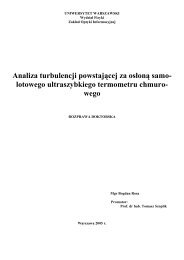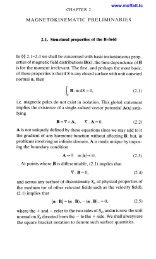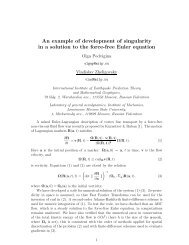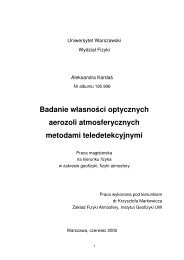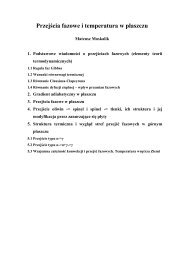Point collapse in octahedral, vortical flows
Point collapse in octahedral, vortical flows
Point collapse in octahedral, vortical flows
You also want an ePaper? Increase the reach of your titles
YUMPU automatically turns print PDFs into web optimized ePapers that Google loves.
<strong>Po<strong>in</strong>t</strong> <strong>collapse</strong> <strong>in</strong> <strong>octahedral</strong>, <strong>vortical</strong> <strong>flows</strong><br />
Richard B. Pelz<br />
Rutgers University, Mechanical & Aerospace Eng<strong>in</strong>eer<strong>in</strong>g<br />
pelz@jove.rutgers.edu<br />
Octahedral <strong>flows</strong> are the set of <strong>flows</strong> which are <strong>in</strong>variant under the f<strong>in</strong>ite <strong>octahedral</strong><br />
group of transformations[1]. The 8C 3 rotational symmetries about l<strong>in</strong>es through opposite<br />
vertices <strong>in</strong>fer the velocity-field permutation u(x, y, z) = v(z, x, y) = w(y, z, x).<br />
At zero-planes, across which there are the reflectional symmetries 3σ n , the normal<br />
velocity is odd and the parallel components are even.<br />
A subset of <strong>octahedral</strong> <strong>flows</strong>, <strong>in</strong> which a compact vorticity distribution exists on<br />
the zero planes, are considered as candidates for f<strong>in</strong>ite-time blowup of the unforced,<br />
Euler equations for three-dimensional, <strong>in</strong>compressible <strong>flows</strong>. Numerical simulations<br />
of these <strong>octahedral</strong>, <strong>vortical</strong> <strong>flows</strong> suggest that an <strong>in</strong>ner solution develops about the<br />
orig<strong>in</strong> with the Leray scal<strong>in</strong>g[2], a self-similar, po<strong>in</strong>t <strong>collapse</strong>.<br />
The reasons why <strong>octahedral</strong>, <strong>vortical</strong> <strong>flows</strong> could blowup spontaneously <strong>in</strong> f<strong>in</strong>ite<br />
time will be discussed <strong>in</strong> this talk. Firstly, the orig<strong>in</strong> of <strong>octahedral</strong> <strong>flows</strong> is a highly<br />
degenerate critical po<strong>in</strong>t. A Taylor series expansion of the velocity <strong>in</strong> x shows only<br />
odd terms are nonzero with the l<strong>in</strong>ear terms be<strong>in</strong>g zero. The reflectional symmetries,<br />
3σ n , p<strong>in</strong> the <strong>in</strong>com<strong>in</strong>g and outgo<strong>in</strong>g manifolds to the axes (l<strong>in</strong>es through opposite<br />
vertices), whereas the three-fold rotational symmetries, 8C 3 , restrict all axis <strong>flows</strong><br />
to be either <strong>in</strong>com<strong>in</strong>g or outgo<strong>in</strong>g. Analysis of the third order terms shows that if<br />
the axes are <strong>in</strong>com<strong>in</strong>g, then the diagonals (l<strong>in</strong>es through the centroids of opposite<br />
faces) are outgo<strong>in</strong>g (or vice-versa).<br />
The <strong>vortical</strong> flow is then constructed to have vortex tubes extend<strong>in</strong>g normally<br />
from the reflectional symmetry planes (zero-planes). The vorticity <strong>in</strong> the plane must<br />
be positive <strong>in</strong> the first quadrant and the centroid be above the diagonal. The vortex<br />
l<strong>in</strong>es have a large radius of curvature with respect to the distance from the centroid<br />
to the orig<strong>in</strong>. Such a flow is then dipolar and makes the axes all <strong>in</strong>com<strong>in</strong>g manifolds.<br />
The rotational symmetries, 8C 3 , allow an <strong>in</strong>duced stra<strong>in</strong> rate from the image<br />
dipoles to have as its maximum direction the axial direction of the fundamental<br />
vortex dipole. Thus, restrictions of vortex-l<strong>in</strong>e curvature surround<strong>in</strong>g self-stretch<strong>in</strong>g<br />
of a vortex tube[3] have been removed. They are replaced, however, by the constra<strong>in</strong>t<br />
that the images must cont<strong>in</strong>ually move closer to the fundamantal <strong>in</strong> time. The<br />
curvature of the vortex l<strong>in</strong>es will become s<strong>in</strong>gular, if the tube <strong>collapse</strong>s <strong>in</strong>to the<br />
acute-angled corner set up by the symmetries.<br />
Thus, all the <strong>in</strong>gredients for po<strong>in</strong>t <strong>collapse</strong> are <strong>in</strong> this picture: <strong>vortical</strong> <strong>flows</strong> with<br />
<strong>octahedral</strong> symmetries can be constructed with six dipoles straddl<strong>in</strong>g each <strong>in</strong>com<strong>in</strong>g<br />
manifold each immersed <strong>in</strong> a stra<strong>in</strong> rate field with the most positive eigendirection<br />
be<strong>in</strong>g parallel to the vorticity. Numerical simulations suggest that this highly constructed<br />
flow does keep its configuration and does <strong>collapse</strong> <strong>in</strong> a self-similar manner[4],<br />
see the figure. New results will be presented which, with hope, further support this<br />
scenario.<br />
1
Figure 1: On the left is an isosurface plot of vorticity magnitude from a pseudospectral<br />
simulation with <strong>in</strong>itial condition u = s<strong>in</strong> x(cos 3y cos z − cos y cos 3z). The time and magnitude<br />
are: t = 1.5, |ω| = .8|ω| ∞ . On the right is the location of vortex filaments at a late<br />
time <strong>in</strong> a simulation. The vortex filament calculation is meant to be a 1-d model of the full<br />
field simulation. The surface <strong>in</strong>dicates the size of the core at each po<strong>in</strong>t on the polygonal<br />
curve. Shown on both is an octahedron which <strong>in</strong>dicates the enforced symmetries.<br />
References<br />
[1] Lomont, J.S. (1959). Applications of F<strong>in</strong>ite Groups, (Academic Press, New<br />
York).<br />
[2] Leray, J. (1934). Sur le mouvement d’un liquide visqueux emplissant l’space.<br />
Acta Math. 63 193-248.<br />
[3] Constant<strong>in</strong>, P. (1994). Geometric statistics <strong>in</strong> turbulence. SIAM Review 36, 73.<br />
[4] Pelz, R.B., (2001) Symmetry and the Hydrodynamic Blowup Problem, J. Fluid<br />
Mech. to appear. Pelz, R.B. (1997). Locally self-similar, f<strong>in</strong>ite-time <strong>collapse</strong> <strong>in</strong><br />
a high-symmetry vortex filament model. Phys. Rev. E 55 1617. Pelz, R.B. and<br />
Gulak, Y. (1997). Evidence for a Real-Time S<strong>in</strong>gularity <strong>in</strong> Hydrodynamics from<br />
Time Series Analysis Phys. Rev. Lett. 79 No. 25 pp. 4998-5001. Boratav, O. N.<br />
& Pelz, R. B. (1994). Direct Numerical Simulation of Transition to Turbulence<br />
from a High-Symmetry Initial Condition. Phys. Fluids 6, 2757–2784.<br />
2


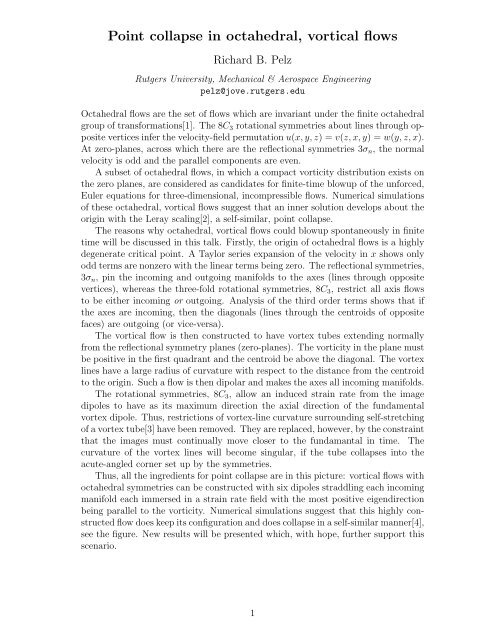


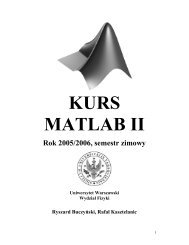
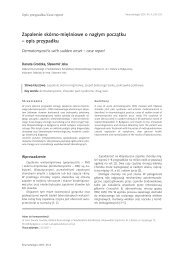
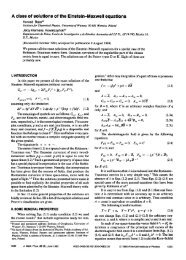
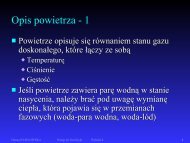
![slajdy [PDF, 0,6 MiB] - Instytut Geofizyki](https://img.yumpu.com/22546539/1/190x143/slajdy-pdf-06-mib-instytut-geofizyki.jpg?quality=85)
